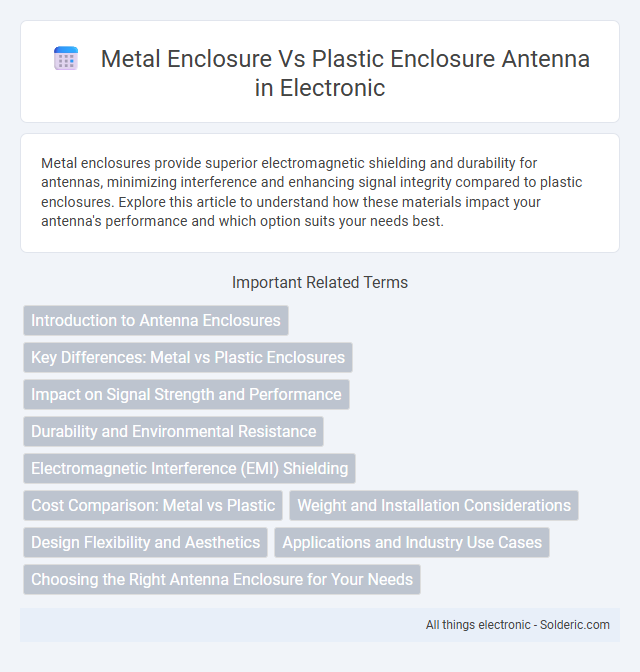Metal enclosures provide superior electromagnetic shielding and durability for antennas, minimizing interference and enhancing signal integrity compared to plastic enclosures. Explore this article to understand how these materials impact your antenna's performance and which option suits your needs best.
Comparison Table
| Feature | Metal Enclosure Antenna | Plastic Enclosure Antenna |
|---|---|---|
| Durability | High resistance to impact and environmental factors | Moderate durability, prone to cracks under stress |
| Signal Interference | Can cause signal attenuation due to metal shielding | Minimal interference; better signal transmission |
| Weight | Heavier, affects portability | Lightweight, easy to handle and install |
| Cost | Generally more expensive due to material and manufacturing | Cost-effective and cheaper to produce |
| Heat Dissipation | Excellent heat dissipation properties | Poor heat dissipation, potential overheating risk |
| Applications | Industrial, rugged outdoor use, high durability needs | Consumer electronics, indoor use, less harsh environments |
Introduction to Antenna Enclosures
Metal enclosures provide superior electromagnetic interference (EMI) shielding and enhanced durability for antenna systems, making them ideal for harsh or industrial environments. Plastic enclosures offer lightweight, corrosion-resistant solutions that allow radio signals to pass through with minimal attenuation, benefiting applications needing improved signal quality. Your choice between metal and plastic antenna enclosures depends on factors like environmental exposure, signal integrity, and mechanical protection requirements.
Key Differences: Metal vs Plastic Enclosures
Metal enclosures provide superior electromagnetic interference (EMI) shielding, enhancing antenna performance by reducing signal degradation, whereas plastic enclosures offer better flexibility in design and lower weight. Metal's durability and heat dissipation make it ideal for harsh environments, while plastic enclosures resist corrosion and are typically more cost-effective. Your choice between metal and plastic antenna enclosures should consider environmental conditions, budget constraints, and specific performance requirements.
Impact on Signal Strength and Performance
Metal enclosure antennas often provide superior durability and shielding against electromagnetic interference, but may cause signal attenuation due to metal's reflective properties, impacting signal strength negatively. Plastic enclosure antennas typically allow better signal transmission with minimal attenuation, enhancing performance in wireless communication by reducing signal losses. Choosing between metal and plastic enclosures depends on balancing physical protection with optimal signal propagation requirements.
Durability and Environmental Resistance
Metal enclosure antennas offer superior durability and enhanced resistance to environmental factors such as UV rays, moisture, and extreme temperatures, making them ideal for harsh outdoor conditions. Plastic enclosure antennas, while lightweight and cost-effective, may degrade faster under prolonged exposure to sunlight and harsh weather, potentially compromising performance. Choosing metal enclosures ensures long-term reliability and protection against physical impacts and corrosion, critical for industrial and outdoor wireless applications.
Electromagnetic Interference (EMI) Shielding
Metal enclosures provide superior Electromagnetic Interference (EMI) shielding due to their conductive properties that block and reflect electromagnetic waves, preventing signal degradation. Plastic enclosures offer limited EMI protection, often requiring additional conductive coatings or internal shielding layers to achieve comparable performance. Effective EMI shielding in metal enclosures guarantees improved antenna signal integrity and reduces interference in high-frequency applications.
Cost Comparison: Metal vs Plastic
Metal enclosures for antennas typically incur higher costs due to the use of durable materials like aluminum or steel, which offer superior shielding and heat dissipation. Plastic enclosures, often made from ABS or polycarbonate, are more cost-effective and lightweight but may compromise on durability and electromagnetic interference protection. Evaluating your budget against performance needs will help determine whether a metal or plastic antenna enclosure is the better investment.
Weight and Installation Considerations
Metal enclosure antennas offer greater durability and shielding but tend to be heavier, impacting your installation process by requiring sturdier mounting hardware and support structures. Plastic enclosure antennas are significantly lighter, easing installation and reducing strain on mounting points, making them ideal for applications where weight is a critical factor. Choosing between metal and plastic enclosures depends on balancing durability needs with installation constraints related to weight.
Design Flexibility and Aesthetics
Metal enclosure antennas offer limited design flexibility due to their rigid material properties, restricting complex shapes and intricate detailing. Plastic enclosure antennas provide greater design versatility, allowing for customized shapes, colors, and finishes that enhance aesthetic appeal and integrate seamlessly with various product designs. The lightweight nature of plastic also enables sleeker, more modern-looking antenna housings without compromising functionality.
Applications and Industry Use Cases
Metal enclosure antennas dominate in aerospace and defense industries due to their superior electromagnetic interference (EMI) shielding and durability in harsh environments. Plastic enclosure antennas are widely used in consumer electronics and smart home devices, where lightweight construction and cost efficiency are critical. Automotive and telecommunications sectors employ both types, selecting metal for robust outdoor applications and plastic for interior or flexible design requirements.
Choosing the Right Antenna Enclosure for Your Needs
Metal enclosures provide superior electromagnetic interference (EMI) shielding and durability, making them ideal for industrial or harsh environmental applications where signal integrity is critical. Plastic enclosures offer lightweight, cost-effective solutions with excellent corrosion resistance and flexibility in design, suitable for consumer electronics and indoor use. Your choice depends on factors like environmental exposure, signal performance requirements, and mechanical protection needs.
metal enclosure vs plastic enclosure antenna Infographic

 solderic.com
solderic.com